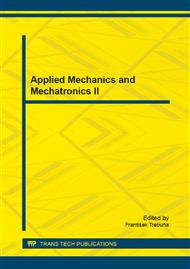[1]
L. A. Zadeh. Fuzzy sets. Information & Control, vol. 8, 1965, pp.338-353.
Google Scholar
[2]
L. A. Zadeh, J. Kacprzyk. Fuzzy Logic for the Management of Uncertainty. J. Wiley & Sons, New York (1992).
Google Scholar
[3]
E. Mamdani, S., Assilian. An experiment in linguistic synthesis with a fuzzy logic control. International Journal of Man-Machine Studies, Vol. 7, 1975, p.1–13.
DOI: 10.1016/s0020-7373(75)80002-2
Google Scholar
[4]
T. Takagi, M. Sugeno. Fuzzy identification of systems and its applications to modeling and control. IEEE Trans. on Systems, Man, and Cybern, Vol. 15, 1985, p.116–132.
DOI: 10.1109/tsmc.1985.6313399
Google Scholar
[5]
V. Novák. Linguistically Oriented Fuzzy Logic Control and Its Design. International Journal of Approximate Reasoning, vol. 12, 1995, pp.263-277.
DOI: 10.1016/0888-613x(94)00037-4
Google Scholar
[6]
V. Novák. Fuzzy modeling principles (in Czech). 1. ed. BEN-Technická literatura, Praha, 2000, 175 pp. ISBN 80-7300-009-1.
Google Scholar
[7]
V. Novák. Genuine Linguistic Fuzzy Logic Control: Powerful and Successful Control Method. Computational Intelligence for Knowledge-Based Systems Design, Hüllermeier, E. and Kruse, R. and Hoffmann, F. (eds. ), Springer, Berlin, 2010, pp.634-644.
DOI: 10.1007/978-3-642-14049-5_65
Google Scholar
[8]
V. Novák, I. Perfilieva. Evaluating Linguistic Expressions and Functional Fuzzy Theories in Fuzzy Logic. Computing with Words in Information/Intelligent Systems 1, L. A. Zadeh a J. Kacpryk (eds. ), Springer-Verlag, Heidelberg, 1999, pp.383-406.
DOI: 10.1007/978-3-7908-1873-4_17
Google Scholar
[9]
HUMUSOFT. CE 150 Helicopter Model [on-line], 2014 [cit 2015-03-17]. Available on web: http: /www. humusoft. cz/produkty/models/ce150.
Google Scholar
[10]
A. Dvořák, H. Habiballa, V. Novák, V. Pavliska, The concept of LFLC 2000 - its specificity, realization and power of applications. COMPUT IND. 2003, sv. 51, s. 269-280. ISSN 0166-3615.
DOI: 10.1016/s0166-3615(03)00060-5
Google Scholar
[11]
R. Farana, B. Walek, M. Janošek, J. Žáček. Fuzzy-Logic Control in Fast Technological Processes. In Proceedings of the 2014 15th International Carpathian Control Conference (ICCC). Velke Karlovice, Czech Republic: VŠB-TU Ostrava, 28. – 30. 6. 2014, p.105.
DOI: 10.1109/carpathiancc.2014.6843578
Google Scholar
[12]
J. E. Takosoglu, P. A. Laski, S. Blasiak. A fuzzy logic controller for the positioning control of an electro-pneumatic servo-drive. Journal of Systems and Control Engineering, volume 226, Issue 10, November 2012, pp.1335-1343.
DOI: 10.1177/0959651812456498
Google Scholar
[13]
W. F. Godoy, I. N. Da Silva, A. Goedtel, R. C. H. Palácios. Fuzzy logic applied at industrial roasters in the temperature control. In 11th IFAC Workshop on Intelligent Manufacturing Systems, IMS 2013, Sao Paulo, Brazil, 2013, pp.450-455.
DOI: 10.3182/20130522-3-br-4036.00028
Google Scholar
[14]
J. Velagic, N. Osmic. Fuzzy-Genetic Identification and Control Structures for Nonlinear Helicopter Model. Intelligent Automation & Soft Computing, Volume 19, Issue 1, pp.51-68, ISSN 1079-8587. DOI: 10. 1080/10798587. 2013. 771454.
DOI: 10.1080/10798587.2013.771454
Google Scholar


